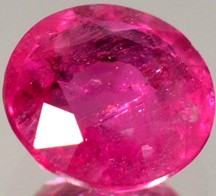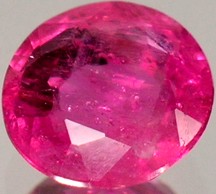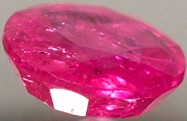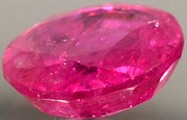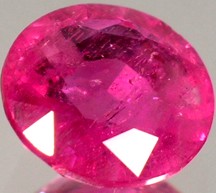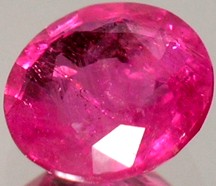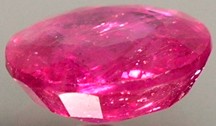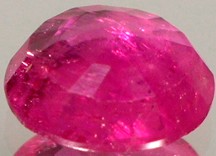|
For Customers outside of USA 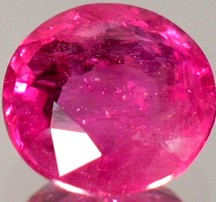
One Gorgeously Colored Handcrafted Antique Genuine Natural Faceted Two (Plus) Carat Neon Red-Orange-Pink Sapphire Round Cut Precious Gemstone from Russia. ORIGIN: 19th Century Russia. SIZE: Diameter: 8mm. Depth: 3 1/2mm. Measurements approximate. WEIGHT: Approximately 2.04 carats. NOTES: Upon request we can set your gemstone as a ring, pendant, or earring.
DETAIL: A gorgeous, vibrantly colored natural red-orange-pink sapphire precious gemstone from the Southern Ural Mountains of Siberia, Russia. The gemstone was hand crafted and faceted by a 19th century Russian artisan, part of an heritage renown for the production of the elaborate gemstones and jewelry of the Czars of Medieval, Renaissance, and Victorian Russia. The faceted cut is a coarse precursor to what eventually became known in the industry as a "brilliant cut" round, the contemporary finish generally given to round diamonds. The color is absolutely magnificent - a bright, intense, almost neon red, with pink and orange/peach undertones. The color is popularly known as "padparadsha" red, and both the intense hue and the fiery sparkle are remarkable. The color is quite exquisite, with very nice sparkle. This sparkling precious gemstone is transparent. Once set it would be near eye clean. The casual admirer would be unlikely to notice any blemishes with a cursory appreciative glance. However close inspection, especially unset, will reveal that the gemstone is lightly blemished. Even lightly blemished, it nonetheless possesses a highly desirable bright red-orange-pink color, vibrant character, and sparkles of fiery, brilliant bright red flashes. It is "near eye clean" to the cursory glance of the casual admirer, and it is transparent, especially as opposed to lower value translucent gemstones. However the gemstone is not anywhere near flawless. As described, if examined critically by one with fairly good visual acuity, even without the aid of a jeweler's loupe, if held within a few inches of the eye, one can pick out a generous sprinkling of predominantly colorless to lightly toned crystalline blemishes with the unaided eye.
There's a couple of light, thin seams of crystalline material within the gemstone, which are just a little darker than the background and so are fairly easy to pick out in these photo enlargements or in a jeweler's loupe. Though they are not even visible from most angles of view, if one looks carefully and moves the gemstone around, eventually you'll catch sight of them. There are also some sprinkles of colorless (or lightly toned) crystalline particles as well. None of the colorless crystalline material is easy to spot with the naked eye unless you hold them gemstone within a few inches of your eye. It is a little easier to see if you turn the gemstone upside down. Of course, once mounted, you'll not see the gemstone from the bottom or the sides, so this fine colorless crystalline material, both seamed and particulate, will be very difficult to discern. Some of the finely sprinkled particulate matter appears to be mica schist (both sapphire and ruby are generally formed in schist). The minute mica schist particles which can be seen in these photo enlargements are by and large not discernible with the naked eye except to very close scrutiny, and then they can only be distinguished as pin-point little specks. They are easiest to pick out if you look from the backside of the gemstone with a jeweler's loupe. However to the naked eye, especially from the front size of the gemstone, they are not very easy to discern, even to scrutiny. These dispersed mica schist particles also manifest themselves at certain angles as a little iridescence, known in the trade as "schiller", which is more often than not caused by microscopic-sized mica particles within the gemstone. Although it is only visible from certain angles, and you have to "play" with the gemstone to see it, it almost looks like the iridescence one sees when an oil sheen is floating atop still water. The most common form of this schiller or iridescence is found in opal. At some angles the schiller is discernible to the naked eye. However from most angles of view it does not show.
All of this of course is observable with a jeweler's loupe, or in these 500% photo enlargements. To the naked eye of the casual admirer, the gemstone appears if not near eye clean, then only lightly blemished. In fact again, to the cursory glance, the gemstone is clean. We're just playing "Devil's Advocate" in the name of full disclosure. And of course most natural sapphire gemstones are anywhere from lightly to heavily included. Unfortunately most transparent "sapphires" sold even by the largest and most reputable retailers in the United States are synthetic (read the fine print; and the same is true of emeralds and rubies). While this particular specimen might not be anywhere near flawless, to casual scrutiny it is at least transparent and if not "near eye clean", then only (moderately) lightly blemished. And it is most assuredly not synthetic, and is nonetheless a remarkable beautiful and vividly colored gemstone. While in these 500% photo enlargement these imperfections seem quite obvious, the majority of the tiny blemishes this padparadsha sapphire does possess will be much more difficult to discern once the gemstone is set into a pendant or ring. As it is the only way to easily see these blemishes with the naked eye is to hold the gemstone up to a light source and scrutinize it carefully. By and large, whatever sins the critic might find, to the eye of the casual admirer it is simply a bright red-orange-pink sapphire of gorgeous color, the dispersed miniscule blemishes are not really immediately discerned by the naked eye, at least to the normal casual admirer, and the brightly colored gemstone possesses very handsome luster and very nice sparkle and flash as well!
While this gorgeous precious gemstone is not absolutely flawless, it is most certainly toward the higher end of the quality spectrum. Under magnification the gemstone shows the unmistakable characteristics of having been hand crafted. The coarseness of the 19th century finish is considered appealing to most gemstone collectors, and is not considered a detriment, or detract from the value of a gemstone. These characteristics are not only expected of hand-finished gemstones, most serious collectors consider such gemstones more desirable, possessed of greater character and uniqueness when compared to today's cookie-cutter mass-produced machine-faceted gemstones. Unlike today's computer controlled machine produced gemstones, the cut and finish of a gemstone such as this is the legacy of an artisan who lived two centuries ago. This gemstone has great luster and color, superb sparkle, and to the eye is absolutely transparent. But again, of course, we want to emphasize that this does not mean it is entirely flawless. True, the blemishes it possesses are not easily discerned by the naked eye - at least to casual scrutiny. As stated, to casual scrutiny it is simply a brightly colored sapphire gemstone of wonderful color and sparkle. However in these 500% photo enlargements you can see some of the sparkly mica blemishes, the colorless or lightly toned crystalline material, the rutile (stranded) mica schist, as well as occasional irregularities in the cut and finish. Naturally these characteristics are not only expected of hand-finished gemstones, you must also consider that two centuries ago the mining techniques even possible then, let alone in practice, did not allow the ultra deep mining operations which are so commonplace today.
Keep in mind that two centuries ago mankind was more or less limited to surface deposits or near surface deposits of gemstones. Higher quality gemstones which today are routinely mined from beneath hundreds of meters, even kilometers beneath the earth's surface, were simply inaccessible then. It is for this reason that antique gemstones must be appreciated as antiques first, gemstones second. The relatively superlative quality of contemporary gemstones routinely mined from deep beneath the earth's surface today were simply not accessible two centuries ago, or at least, only rarely so. However for most, the unique nature and character of antique gemstones such as this more than makes up for included imperfections which by and large, are only visible under magnification. HISTORY: Sapphires have been since ancient times one of the most highly valued of all gemstones, and references to the gemstone date back to about 800 B.C. The name "sapphire" comes from the Latin "sapphirus" and the Greek "sappheiros", which translates to "blue" in both languages. The name sapphire is also a derivative of the ancient Hebrew and Persian word for "blue" as well. To the ancient Romans however, the word "sapphirus" actually referred to lapis lazuli, another blue gemstone. What the Romans called blue sapphire translates to "hyacinth"; the green sapphire was "emerald", and the purple sapphire was "amethyst". In the ancient Mediterranean world, priests and sorcerers honored the sapphire above all other gems. They believed that the sapphire enabled them to interpret oracles and foretell the future.
The ancient Persians believed that the earth rested on an enormous sapphire, and the sky reflected its beautiful color. They referred to the sapphire as "the gem of the heavens". As the centuries passed, European royalty came to favor sapphire believing the stone would provide protection from harm. Throughout Medieval Europe, the sapphire was thought to give the wearer strengthened vision, including visions of the future. Sapphire was regarded as an antidote to black magic and effects of evil spirits. It was held to be a symbol of truth and constancy. Sapphires are a member of the corundum family, and close relative to the ruby. In fact, a ruby is simply a red sapphire. The sapphire is considered one of the most valuable of precious stones. The principal sources of sapphire in modern history are Russia, Siam, Ceylon, Burma, Africa, and Australia.
SHIPPING OPTIONS: All purchases are backed by an unlimited guarantee of satisfaction and authenticity. If for any reason you are not entirely satisfied with your purchase, you may return it for a complete and immediate refund of your entire purchase price. Most of these antique gemstones were originally part of two collections, one originating in India principally composed of gemstones originally mined in India, Burma, Ceylon, and Siam, and then hand faceted in India. The addition of a second accumulation of antique gemstones originally mined in the Urals in the mid to late 19th century (including alexandrite) completed the collection. These gemstones as well were hand finished. The Urals have been one of the world's major sources of precious and semi-precious gemstones for many centuries. As well, additional specimens are occasionally acquired from other institutions and dealers in Eastern Europe and Asia. These antique gemstones are now in the United States and are available for immediate delivery. We ship inventory from the USA order fulfillment center near Seattle, Washington. Your purchase will ordinarily be shipping within 48 hours of payment. A certificate of authenticity is available upon request. We prefer your personal check or money order over any other form of payment - and we will ship immediately upon receipt of your check (no "holds"). We will accept PayPal payments. Please see our "ADDITIONAL TERMS OF SALE".
|
|---|
